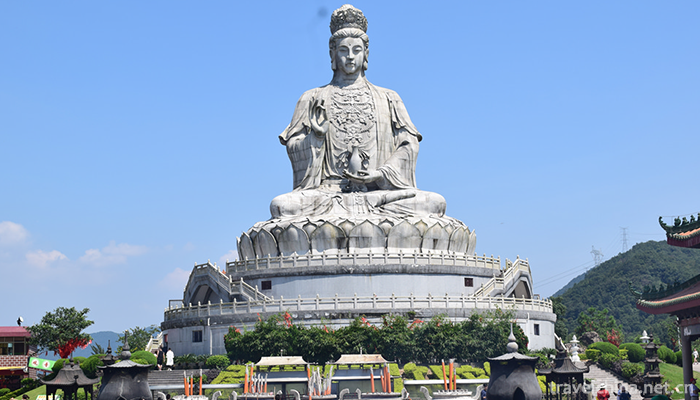Guanyin legend
Guanyin legend
Guanyin legend is one of the ancient local folklores in Zhoushan, Zhejiang Province. It is one of the second batch of national intangible cultural heritage list published by the State Council. The goodness of Guanyin's great compassion and the virtue of saving suffering and rescuing sufferings have been widely believed in among the Chinese people, and have been spread to Japan and Southeast Asian countries for a long time. With its extensive and profound Guanyin culture and beautiful natural scenery, Putuo Mountain attracts a large number of fragrant tourists every year. These cultural and realistic backgrounds are the solid foundation for the Guanyin legend to be listed in the national intangible cultural heritage list and declared as the world intangible cultural heritage.
On June 7, 2008, the legend of Guanyin was approved by the State Council to be included in the second batch of national intangible cultural heritage list.
Historical origin
The popularity of "Guanyin Legend" is closely related to the widespread belief in local Guanyin. As early as in Song Baoqing's Changguo County Chronicle, there was a record of "Meizen Mountain (today's Putuo Mountain) Guanyin Baotuo Temple". Song Qiandao's "Four Mings Tujing" is a record of "Japanese monk Hui-e delivering Guanyin", and the legend of "refusing to go to Guanyin" has been circulating ever since, and has become an important link of cultural exchanges between China and Japan. Sheng Ximing, a monk in the Western Regions of the Yuan Dynasty, wrote "Biography of Putuo Luo Mountain", and also recorded "Good Money 18 Visits from Zi", "Guan Shiyin 32 Appearing Like Sayings" and "Chaoyin Cave of Sanskrit Monks in the Middle Tang Dynasty". The first ten burnt fingers witnessed the myth of Datu Guanshen and so on. Since the Ming and Qing Dynasties, the Records of Mount Putuo have recorded more myths about Guanyin. The twelve-year-edition of the New Records of Putuo Luoga, a monograph on "Spiritual Gates", recorded 68 myths about various kinds of Guanyin. In addition to the ancient records, as early as the Ming and Wanli Dynasties, the book Guanyin Quanzhuan in the South China Sea was circulated among the people, and in the early years of the Republic of China, the script of Guanyin Dedao was handed down among the people. The legendary image of Guanyin is recorded in classical novels such as Journey to the West and Romance of Fengshen. According to Buddhist legend, the nineteenth of February, nineteenth of June and nineteenth of September in the lunar calendar are the birth, monkhood and Taoism of Guanyin Bodhisattva respectively. They are called the three fragrant clubs. Each day has a story. Therefore, for thousands of years, as a great Bodhisattva with boundless Buddhism and Dharma, Guanshi has been widely praised and believed in folk quilts in Zhoushan. Moreover, this kind of eulogizing and believing in oneself goes far beyond the national and national boundaries, and becomes a kind of Guanyin cultural phenomenon of "persuading people to do good and loving peace" which has spread to all parts of the world.
primary coverage
Among the many Bodhisattvas offered by Buddhism, the most familiar and affectionate one is probably the Guan Shiyin Bodhisattva. Guan Shiyin is a free translation of Sanskrit, also known as Guan Shiyin, Guan Zi and Guan Shi Zi. In the Tang Dynasty, Guan Shiyin was slightly called Guan Yin because it avoided the taboo of Taizong Li Shimin. According to Indian legend, Guanyin Bodhisattva was originally the great prince of the Saint King of the Wheel. He practiced with his brother and served Amitabha Buddha, becoming one of the "Three Saints of the West". Guanyin has the virtue of "great kindness and happiness of all living beings, great compassion and suffering of all living beings". It can present thirty-two incarnations and save twelve kinds of great hardships. Since the Sui and Tang Dynasties, the belief in Guanyin has become popular among the people with the prosperity of Buddhism. The image of Guanyin has gradually departed from the Indian legend pattern and replaced it with the Chinese female image.
According to legend, Mount Putuo is the Taoist arena of Guanyin's manifestation theory. On the 19th of February, 19th of June and 19th of September in the lunar calendar, the legendary Birthday, Sunday and Nirvana Day of Guanyin Bodhisattva come thousands of miles away. The legend of Guanyin is also widely spread here.
Inheritance significance
Mount Putuo has a profound Buddhist culture and has become the belief of Guanyin, which has been claimed to be the belief of most of Asia with the Sinicization of Buddhism. As long as there are Chinese people in the world, they all know Guanyin. The vast majority of Buddhists are Guanyin believers. Protecting and excavating Guanyin culture and promoting the positive connotation of Buddhist culture are good carriers for us to inherit historical culture and build a harmonious society. At the same time, they are people's expectations.
Today, when we build a harmonious world, we should give full play to the special role of Guanyin culture and Guanyin belief, which is a cultural treasure, to benefit all living beings. Because Guanyin culture belongs to Mount Putuo, to the Chinese nation, and even to the human civilization of the whole world.


-
1.Mount Maoshan
Maoshan is located in Jurong City, Zhenjiang City, Jiangsu Province. It is about 10 kilometers long from north to south, 5 kilometers wide from east to west, and covers an area of more than 50 square
Time 2018-12-06 -
2.Four Seasons Hotel Shenzhen
Four Seasons Hotel is an international luxury hotel management group, headquartered in Toronto, Canada. It was founded by Mr. Isado Sharp in 1961. Now it has more than 90 hotels and resorts in nearly
Time 2018-12-16 -
3.Hongjundu Xiwudang Mountain Scenic Area
Hongjundu Xiwudang Mountain Scenic Area is the starting point of the Long March of the Four Red Armies, the memorial site of the Campaign of Strong Crossing Jialingjiang River, the national patriotic
Time 2019-01-16 -
4.The First Sangzi in Jialing
The first Sangzi of Jialing is located in Peng'an County, Sichuan Province. Peng'an is the home of Sima Xiangru, a great poet of the Han Dynasty. It is located in the northeast of Sichuan
Time 2019-01-21 -
5.Qingming Bridge Ancient Canal Scenic Area
Qingming Bridge Ancient Canal Scenic Area is located at the southern end of Wuxi city center, covering about 44 hectares of scenic area. The scenic spot is composed
Time 2019-02-07 -
6.Tangya Tusi City Site
Tangya Tusi Town Site is located in Tangya Town, Xianfeng County, Enshi Tujia and Miao Autonomous Prefecture, Hubei Province, with its back to Xuanwu Mountain and facing Tangya River.
Time 2019-02-13 -
7.Genghis Khan Festival
Genghis Khan's sacrifice is a Mongolian custom of offering sacrifices to Genghis Khan. It originated in the Wokuotai era, and was formally issued in the Kublai Khan era. It stipulated various sacrific
Time 2019-04-18 -
8.Hu Xueyan
Hu Xueyan (1823-1885), Hu Guangyong, the younger name, Shun Guan. Xue Yan, born in Anhui Huizhou Jixi He moved to Zhejiang when he was 13 years old. Hangzhou Famous in modern China red top A politicia
Time 2019-09-07 -
9.Anhui Science And Technology University
Anhui Science and Technology University is located Anhui Province Chuzhou City Fengyang County and Bengbu City By the state Ministry of Education Approved full-time full-time undergraduate universitie
Time 2019-10-10 -
10.Social security in Deyang
In 2018, there were 748000 employees participating in basic endowment insurance, 345000 in unemployment insurance, 752000 in medical insurance, 384000 in industrial injury insurance and 399000 in maternity insurance. In the whole year,
Time 2020-12-14 -
11.Nanchong ecological environment
In 2019, the total amount of funds used for environmental protection capacity building and supervision and operation of Nanchong City is 14.1809 million yuan, including 2.4476 million yuan for monitoring capacity construction and 11.7333 million yuan for environmental
Time 2020-12-17 -
12.Guangan secondary industry
In 2019, the industrial added value of Guang'an City will reach 28.87 billion yuan, an increase of 8.8%, and its contribution rate to economic growth will be 34.9%. At the end of the year, there were 597 Industrial Enterprises above Designated Size, and
Time 2020-12-19